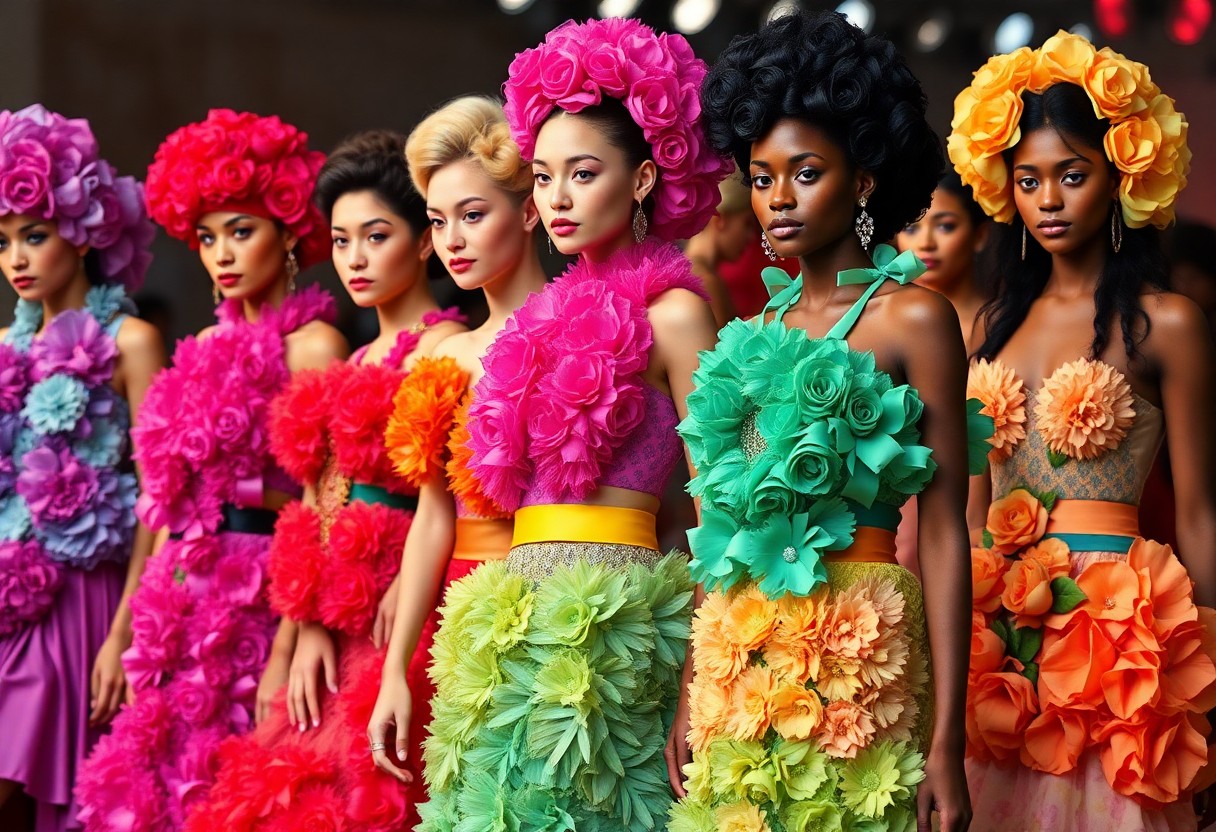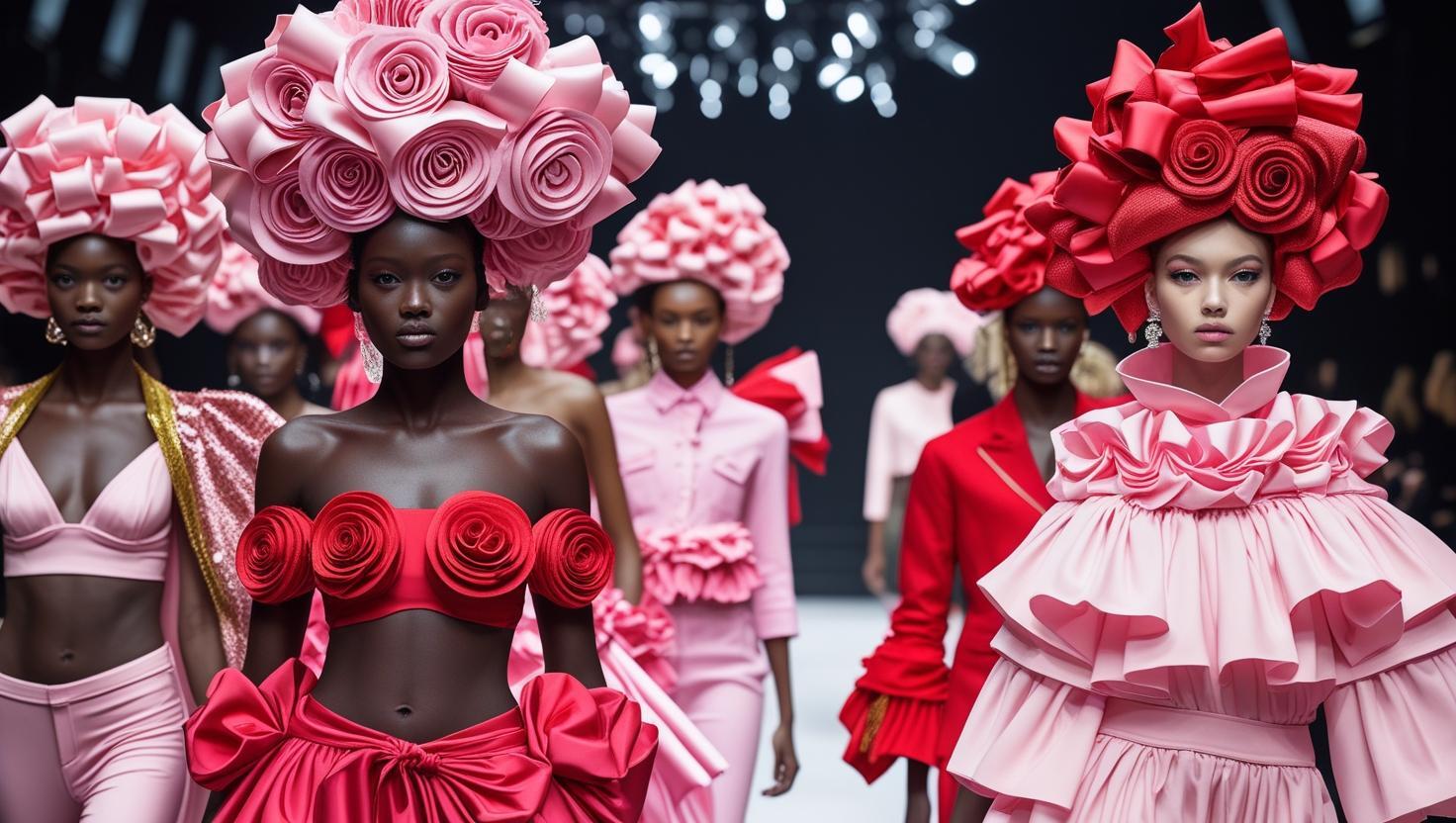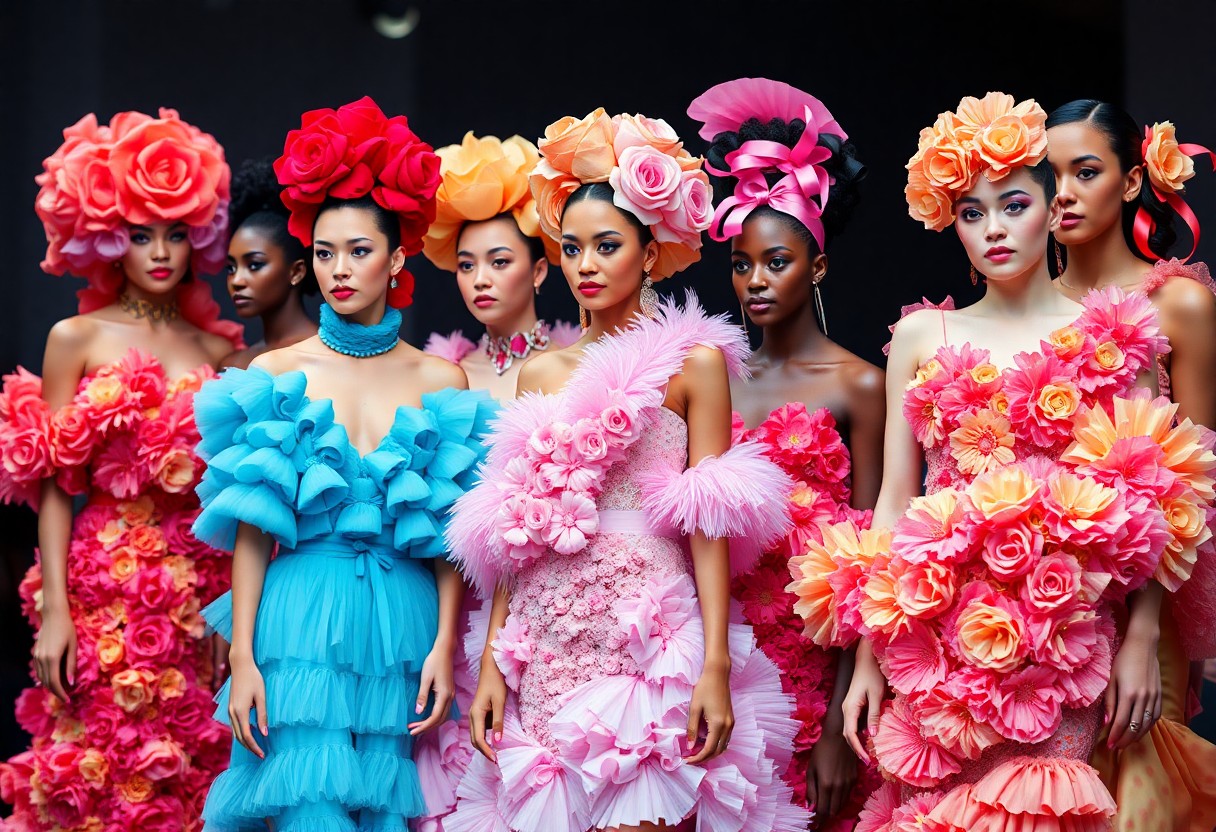24th Jun 2025
Rosettes & Ribbons: How Hyper-Femininity Is Reclaiming the Runway in 2025

The Resurgence of Femininity on the Catwalk
You’ve likely noticed how designers like Molly Goddard and Simone Rocha are amplifying hyper-femininity with layers of tulle, oversized rosettes, and cascading ribbons. At London Fashion Week alone, more than 40% of collections embraced these delicate yet bold elements, signaling a clear shift back to romance and softness. This resurgence challenges minimalist trends by placing expressive textures and volumes center stage, inviting you to celebrate femininity not as weakness but as an empowering form of armor on the runway.
Decoding Hyper-Femininity: Beyond the Stereotype
You might assume hyper-femininity is simply about frills and pastel hues, but it goes far deeper—representing a deliberate reclaiming of traditionally feminine aesthetics as a form of empowerment. Designers today challenge outdated clichés by combining bold silhouettes, luxurious textures, and intricate detailing, crafting looks that assert strength through softness. This movement isn’t about submission to norms but rather a nuanced dialogue between vulnerability and power, where delicate motifs like rosettes and ribbons become symbols of self-expression rather than mere decoration.
Historical Context and Evolution
Tracing back to the Victorian era’s ornate dresses and the 1950s’ hourglass silhouettes, hyper-femininity has long intertwined with societal expectations of women. Over decades, it faced backlash as a sign of conformity, especially with the rise of minimalism and androgyny in fashion’s late 20th century. The 21st century’s revival, however, refashions these visuals—infusing them with contemporary ideologies and artistic innovation, transforming once-dismissed aesthetics into statements of autonomy and creativity.
Key Designers Leading the Charge
Designers like Simone Rocha, Molly Goddard, and Richard Quinn have become pillars of hyper-femininity’s resurgence. Rocha’s delicate organza and pearl embellishments, Goddard’s voluminous tulle dresses, and Quinn’s vibrant floral prints showcase a sophisticated embrace of ornate femininity. Their work consistently blurs the line between fantasy and reality, encouraging you to rethink the power found within traditionally feminine motifs.
Diving deeper, Simone Rocha’s collections often explore contrasts—combining soft fabrics with armor-like structures, highlighting resilience beneath fragility. Molly Goddard transforms childhood dress-up aesthetics into adult couture with saturated colors and exaggerated shapes. Richard Quinn’s runway shows famously burst with abundant floral and ribbon details yet are underscored by sharp tailoring and bold proportions. Their combined influence signals a broader narrative shift, inviting you to wear hyper-femininity not as nostalgia but as bold, modern artistry.

The Aesthetic Manifestation: Trends to Watch
The 2025 runway takes hyper-femininity beyond expectation, spotlighting intricate craftsmanship and bold embellishments. Expect designers to push boundaries with exaggerated silhouettes, from tiered skirts to voluminous puff sleeves. Noteworthy collections at Paris Fashion Week revealed an obsession with tactile details—beading, embroidery, and delicate appliqués—offering you layers of visual and textural richness that command attention. These trends don’t merely dress the body; they transform it into an artful celebration of softness and strength.
Signature Styles: Ruffles, Lace, and Flourishes
You’ll find ruffles cascading along necklines and hems, often paired with intricate lace overlays that evoke Victorian romanticism infused with modern edge. Flourishes like bows, rosettes, and hand-sewn florals add depth and movement to garments, shifting the narrative from passive prettiness to confident femininity. Designers such as Molly Goddard exemplify this with layered tulle gowns and unexpected textures, inviting you to embrace bold, tactile details as a statement rather than mere decoration.
Color Palettes & Fabric Choices: A Celebration of Pastels and Textures
Soft pastels—think blush pink, powder blue, and lilac—dominate the season, offering a delicate yet intentional chromatic palette that balances nostalgia with fresh vitality. Fabrics range from sheer organzas to plush velvets, creating rich contrasts between transparency and opulence. This interplay invites you to experience hyper-femininity through both color and texture, emphasizing how tactile sensations can redefine classic femininity.
Delving deeper reveals a strategic layering of materials, where lightweight chiffons float over structured satins, and matte cottons meet glossy silks, crafting multidimensional looks that feel both ethereal and grounded. Designers are also experimenting with tactile innovations like raised brocades and crinkled taffetas, enriching your sensory engagement with each piece. These fabric choices don't simply complement pastel hues; they amplify emotional resonance, making the act of wearing hyper-feminine fashion a compelling, immersive experience.

Cultural Influences: What’s Shaping the Narrative?
The hyper-feminine revival isn't just a stylistic choice; it reflects evolving societal dialogues around identity and expression. You see designers weaving historical costume references with contemporary ideals, while communities online amplify voices traditionally sidelined in fashion, creating a feedback loop that celebrates softness as strength. This movement honors vintage glamour and bricolage culture alike, proving that femininity can be both nostalgic and subversive. By tapping into cultural textures like queer aesthetics and intersectional narratives, hyper-femininity on runways resonates far beyond fabric—it shapes how you perceive power and vulnerability in style.
The Role of Feminism in Fashion Trends
Feminism’s influence has morphed, guiding you away from austerity toward playfulness and elaborate detailing that reclaim femininity on your terms. You’re witnessing a shift where designers emphasize choice and self-expression over uniform protest styles, with brands like Batsheva and Molly Goddard creating pieces that celebrate nurturing traits alongside independence. The feminist framework now embraces hyper-femininity as a way to resist patriarchal definitions of strength, letting you wear roses and ribbons as symbols of empowerment rather than mere adornment.
Social Media’s Impact on Hyper-Feminine Aesthetics
Platforms like Instagram and TikTok have accelerated hyper-femininity’s visibility, turning runway looks into viral phenomena almost overnight. You follow influencers such as @chrisellelim and @blaireadie who reintroduce frills, ruffles, and pastel palettes into mainstream consciousness, inspiring millions daily. The immediacy and community feedback loops of social media allow trends like puff sleeves and rosettes to evolve dynamically, making the aesthetic feel accessible and relevant to your everyday wardrobe.
Delving deeper, social media's visual culture embodies a democratization of style where you can customize hyper-feminine trends to reflect personal and cultural identities. The rise of “cottagecore” and “soft girl” aesthetics owes much to YouTube tutorials and TikTok challenges, which teach styling tips that blend the extravagant with practical. User-generated content has enabled micro-trends—such as embellished headbands or voluminous skirts—to flourish quickly and globally. This responsiveness creates a fashion ecosystem where you’re not just a spectator but an active participant, making hyper-femininity both a celebration of heritage and a platform for innovation.

Crafting Your Own Hyper-Feminine Wardrobe
Building a hyper-feminine wardrobe revolves around selecting pieces that emphasize delicate details, playful textures, and ornate finishes. Focus on garments that highlight your silhouette while incorporating rosettes, ribbons, lace trims, and pastel colors. Mixing vintage-inspired elements like puff sleeves with modern tailoring allows you to balance softness with sophistication. Fabrics such as chiffon, silk, and tulle bring an ethereal quality that defines hyper-femininity. Your collection should invite creativity, encouraging you to layer, accessorize, and tweak outfits to reflect your unique interpretation of the style.
Key Pieces to Invest In
Start with a selection of statement dresses featuring ruffles, floral appliqués, or ribbon accents—these become foundational pieces for your wardrobe. Incorporate blouses with delicate puff sleeves and lace collars, which easily elevate everyday looks. A quality tailored blazer with feminine details like bow closures or subtle peplum adds structure without sacrificing softness. Don’t overlook skirt options in flowing fabrics or tiered styles to vary your silhouettes. Investing in these imperatives builds versatility and allows you to mix bold hyper-feminine aesthetics with everyday wear.
Styling Tips for Everyday Wear
Balance hyper-feminine elements with minimalist basics to avoid overwhelming your look. Pair a ruffled blouse with high-waisted jeans or tailored pants for a polished yet playful effect. Incorporate subtle accessories like silk scarves tied in bows or delicate rosette brooches to infuse charm into casual outfits. Layer lightweight cardigans or structured jackets to add dimension without clutter. Aim for a refined palette of pastels and neutrals, allowing textures and details to stand out. After experimenting, you’ll find distinctive combinations that make hyper-femininity approachable every day.
For more nuanced styling, focus on the interplay of textures and proportions. Combining a voluminous skirt with a fitted top creates a balanced silhouette that honors hyper-feminine themes without sacrificing comfort. Small accents such as pearl hairpins or embroidered handbags contribute subtle extravagance. Coordinating your color palette across layers ensures cohesion, while mixing vintage and contemporary pieces keeps your wardrobe fresh. Adding structured belts can define your waist, enhancing the exaggerated femininity that rosettes and ribbons evoke. After applying these principles, everyday hyper-femininity feels natural and effortless.
- Incorporate ruffled blouses with neutral bottoms for balanced looks
- Use silk scarves or rosette brooches to accentuate outfits
- Layer with cardigans or blazers to add texture and structure
- Mix vintage accessories like pearl pins with modern staples
- Define your waist using belts to highlight feminine shapes After mastering these tips, your everyday styling will confidently embrace hyper-femininity.
Predicting the Longevity of the Trend
The vibrant surge of hyper-femininity, dominated by rosettes and ribbons, feels more than just a fleeting whimsy in 2025. Designers like Molly Goddard and Giambattista Valli have incorporated these elements season after season, suggesting a staying power beyond initial excitement. Yet, the elasticity of the trend depends on how seamlessly it integrates into everyday wear and the willingness of consumers like you to embrace its bold, unapologetic charm. Its longevity also hinges on evolving narratives around femininity, as culture and style continually negotiate the line between ornamentation and authenticity.
Balancing Between Trend and Timelessness
As you navigate the delicate terrain between trendiness and timelessness, rosettes and ribbons walk a fine line. These motifs, rooted in historical fashion yet refreshed with modern silhouettes, have the potential to transcend seasonal cycles if paired with classic tailoring. By investing in pieces where hyper-femininity meets subtlety—like a structured blazer with ribbon detailing—you keep your wardrobe both current and enduring, allowing the flamboyant to evolve into an elegant statement that thrives beyond the runway’s pulse.
Potential Backlash and Counter-Movements
While rosettes and ribbons flourish, a segment of fashion voices pushes back, favoring minimalism and androgyny that reject overt embellishments. You’ll notice increasing critiques framing hyper-femininity as excessive or outdated, fueling counter-movements focused on stripped-down aesthetics and gender-fluid designs. This tension reflects a broader cultural dialogue over identity and expression, where your choice to embrace or dissent from the trend becomes both a style and ideological decision.
These counter-movements not only challenge the dominance of hyper-femininity on the runway but also encourage innovation in fabric technology and design philosophy. Designers like Telfar Clemens and Marine Serre champion sustainability and inclusivity, advocating for garments that prioritize versatility and function over ornamental excess. The growing market for gender-neutral collections indicates a significant shift, compelling you to consider how fashion's future might favor adaptability and subtlety, potentially relegating rosettes and ribbons to selective, statement-making moments instead of widespread adoption.
Final Thoughts: The Future of Femininity on the Runway
Designers like Erdem and Richard Quinn are pushing hyper-femininity into bold new territories, mixing intricate rosettes with sharp tailoring and unexpected fabrics. You’ll notice how this resurgence isn’t about nostalgia but a deliberate redefinition of softness as strength. With over 35% of spring 2025 runway shows featuring exaggerated ribbons and floral embellishments, the trend signals a shift where feminine details reclaim prominence without sacrificing modern edge. As you curiously explore your own wardrobe, this evolution invites you to embrace hyper-femininity as both a personal armor and a statement of empowerment.



